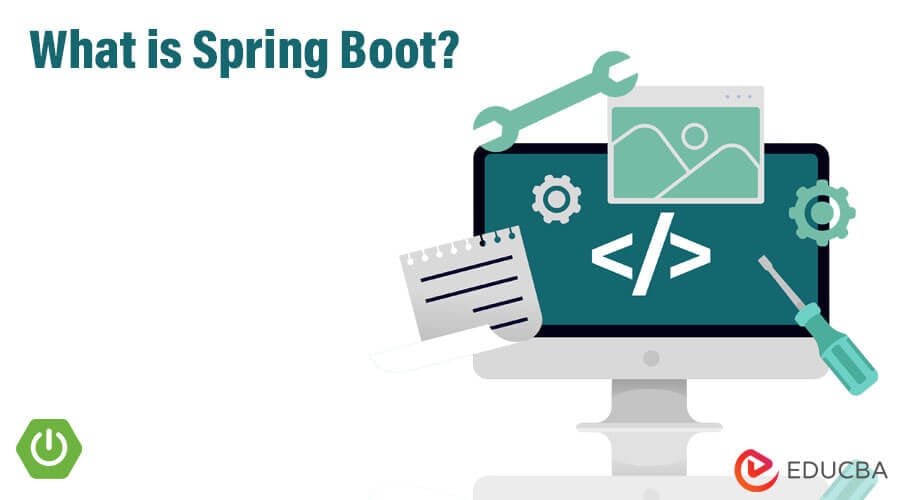Updated March 14, 2023

Introduction to Spring Boot
The popular Java-based framework, Spring Boot, helps in creating Spring applications with microservices. It is an open-source framework that offers flexible XML configurations, database transactions, sturdy batch processing, and relaxed administration of REST services and endpoints. It provides an easy workflow and takes less time than other Java frameworks in the market.
The various roles in the Spring Boot Java Framework include Senior Software Engineer, Spring Java or Application Developer, and Tech Lead or Architect in Spring, although these titles may vary from organization to organization.
Microservices
In relation to Spring Boot, we must also understand the concept of microservices.
A microservice can be defined as an architectural approach that allows developers to build, organize, and operate small, independent services. Each service runs in its own process and serves a specific function, resulting in a lightweight model that can support business applications. Some of its advantages are:
- Easy deposition
- Time-saving (reduces production time)
- Compatible with containers
- Minimum configuration
- Simple scalability
Features
Spring Boot simplifies the process of creating production-grade spring-powered applications and services with minimal effort. It is a framework that helps to bootstrap and develop new Spring Applications quickly. Spring Boot provides default code and annotation configurations to facilitate real-time project startup. It also follows the ‘Opinionated Defaults Configuration’ strategy to minimize the need for boilerplate code and other configurations, improving Unit Test, Development, and Integration Test procedures.
The Spring Boot program achieves the following goals.
- Avoid complex XML configurations
- Easily develop ready-to-use Spring applications
- Reduce time to build and run the developed applications
- Envision an easier way to start the applications
- Flexibility in configuring XML configurations, Java Beans, and Database Transaction
- Provide strong batch processing and even manages REST endpoints of reduced time
- Offer automated spring applications
- No manual configurations required
- Ease the dependency and comes with Embedded Servlet Container
Advantages and Disadvantages of Spring Boot
Given below are the advantages and disadvantages mentioned:
Advantages:
- Spring Boot offers an easy way to create Spring-based applications using Java or Groovy
- Minimizes the time spent in developing and increasing productivity
- Reduces all the manual work of writing annotations, boilerplate codes, and XML configurations
- Easy integration of Spring Boot Application with its Spring Ecosystem, which includes Spring Security, Spring Data, Spring JDBC, and Spring ORM
- With ‘Opinionated Defaults Configuration,’ it also reduces the efforts of developers
- Developers have easy access to Embedded HTTP servers, such as Jetty, and Tomcat, and can easily test web applications
- Easy access to Command Line Interface, which has developed and tested Spring Boot applications developed with Java or Groovy
- Provides a lot of plugins for the development and testing of Spring Boot applications built with tools like Gradle and Maven
- Provides a plugin that has made working with embedded and in-memory databases very smooth.
Disadvantage:
-
The only problem lies in the time required to convert legacy or existing Spring Framework projects into Spring Boot applications.
How can this technology help your career grow?
Currently, this is a trending topic among Java developers who are contemplating their career options. With the broad range of opportunities available, aspiring developers can choose from any of the career paths mentioned below.
1. Spring Java Developer
One who chooses this profession will have the following responsibilities:
- Developing and designing applications.
- Ensuring and delivering maximum performance
- Being able to create efficient and well-structured code
- Playing a role in all phases of SDLC
2. Spring Application Developer
The following are the roles and responsibilities of a Spring Application Developer:
- Having a strong understanding of client requirements
- Possessing communication skills and collaborating with the development team
- Setting conditions for the application which needs to be developed
- Understanding codes thoroughly and writing high-quality, testable code while also creating documentation for the code
- Having the ability to perform unit and integration tests
- Being efficient in debugging and troubleshooting the developed application
- Having knowledge of creating prototypes
- Having a sharp eye for detail
3. Tech Lead in Spring
The key responsibilities are:
- Having problem-solving skills and being proficient in developing solutions and approaches to any technical problem
- Developing, designing, and optimizing the solutions
- Having the ability to work in a team and help the team members build an error-free system
4. Senior Software Engineer
The key responsibilities of a Senior Software Engineer include:
- Possessing team working skills
- Being business-minded and should always look for strategies and plans to scale up the business and its future requirements
- Having deep knowledge of working with automation and other workflows
Conclusion: What is Spring Boot?
Spring Boot simplifies the task of developing a Java application. It aspires to lead the ever-evolving and expanding application-development domain. With more focus on developing new configurations than existing ones, it takes an opinionated approach, thereby giving great relief to the developers.
Recommended Articles
For further understanding of topics related to the subject, please go through the following articles:
